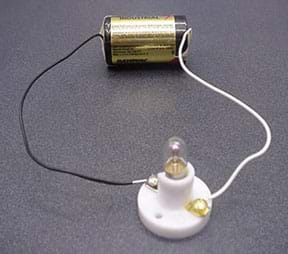When I was in second grade, my mother signed my sister and me up for an after school science club. One of the things we learned did in this club was learn all about different electronics, circuits, and built circuits with different types of switches, etc.
I’ve seen kids with bought electronic “sets”, which is, in my opinion, a waste of money.
All that is needed to teach kids about electricity are a few pieces of conductable wire, preferably covered with insulating materials, some cardboard, metal paper clips, small light bulbs, and AA batteries.

Safe, Simple Electrical Experiments
Batteries, Bulbs, and Wires
Electric Mischief: Battery-Powered Gadgets Kids Can Build
Electricity and Magnetism
Electricity Experiments for Children

365 Simple Science Experiments with Everyday Materials
Battery Science: Make Widgets that Work and Gadgets that Go
Klutz Battery Science
Learning about electronics is a fun past time for kids of all ages. The materials are either cheap or free (as most can be found dumpster diving). These materials are basically non consumables, so even after they have been used for this activity, you can reuse them, either for more activities, or for repairs around your home.
The best thing about this activity is that it is enjoyable for kids, and they’re learning at the same time. Hitting two birds with one stone is really the best way. It helps bring science to life and helps them realize that acquiring knowledge is fun (at least when being taught correctly).
Another electricity related experiment is to give your child a “workshop”. My brother had a little corner in the basement where he would take broken pieces of electronics and unscrew them to find their inner workings. Armed with wire cutters and screw drivers, he’d spend hours in his lair, collecting capacitors, LEDs, and lots of other little things to which I’ve forgotten the name. For children who prefer to take things apart as opposed to building things, taking apart broken electronics is a fun, frugal pastime.
If you read books about how things work, your child may even be able to fix the part that broke, preparing himself for a future career as a mechanic.
Just a note: This activity should be reserved for older children, as the wire cutters and all the little parts could be dangerous.
P.S. I know I was using the pronoun “he” in this whole post. Maybe just a tad non feminist. This activity is also suitable for girls, if they are so inclined (as I am- note I said I did these things in an after school science club) but I am assuming that boys would tend to be more interested in this, which is why I used the pronoun “he”. (As a mom of boys, I also tend to think in terms of “he”.)
Have you ever done electricity experiments with your children? What have you made?




